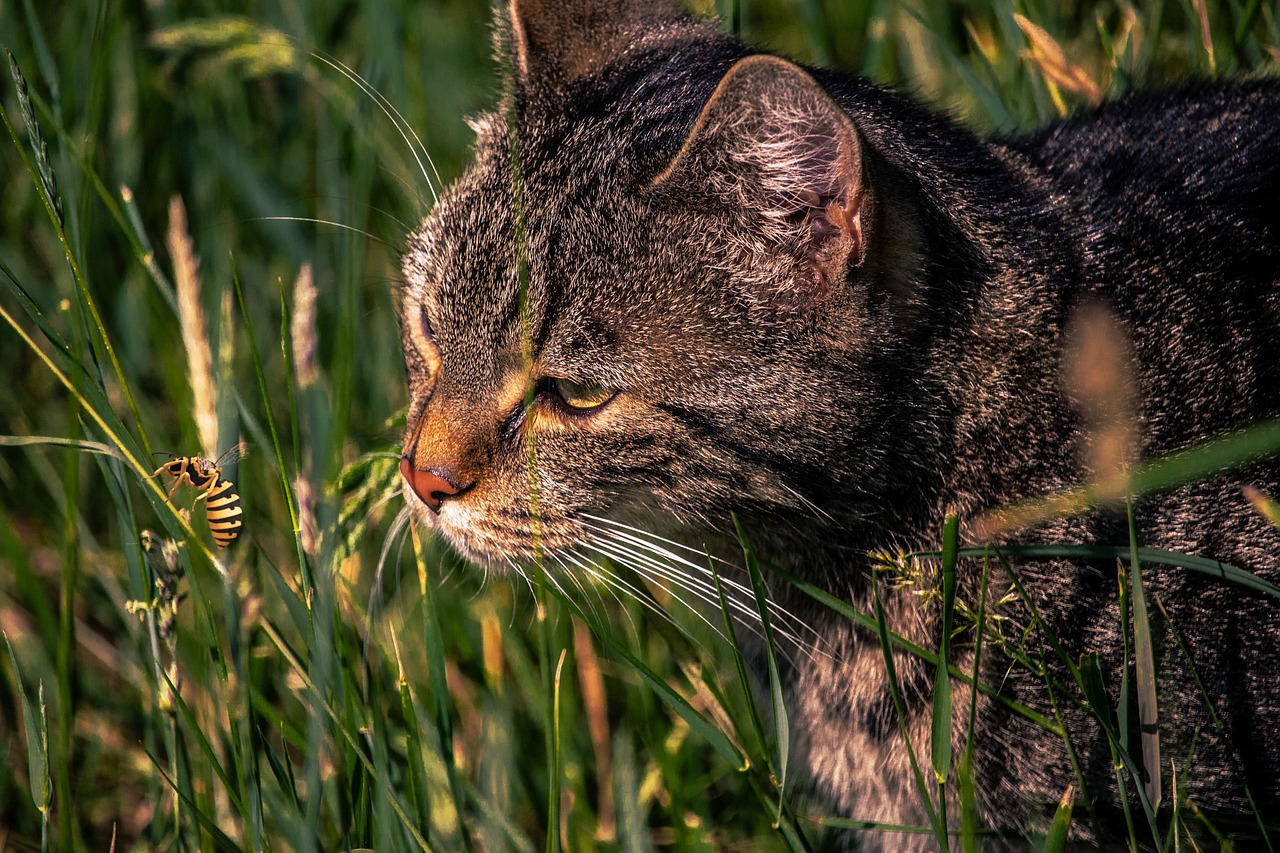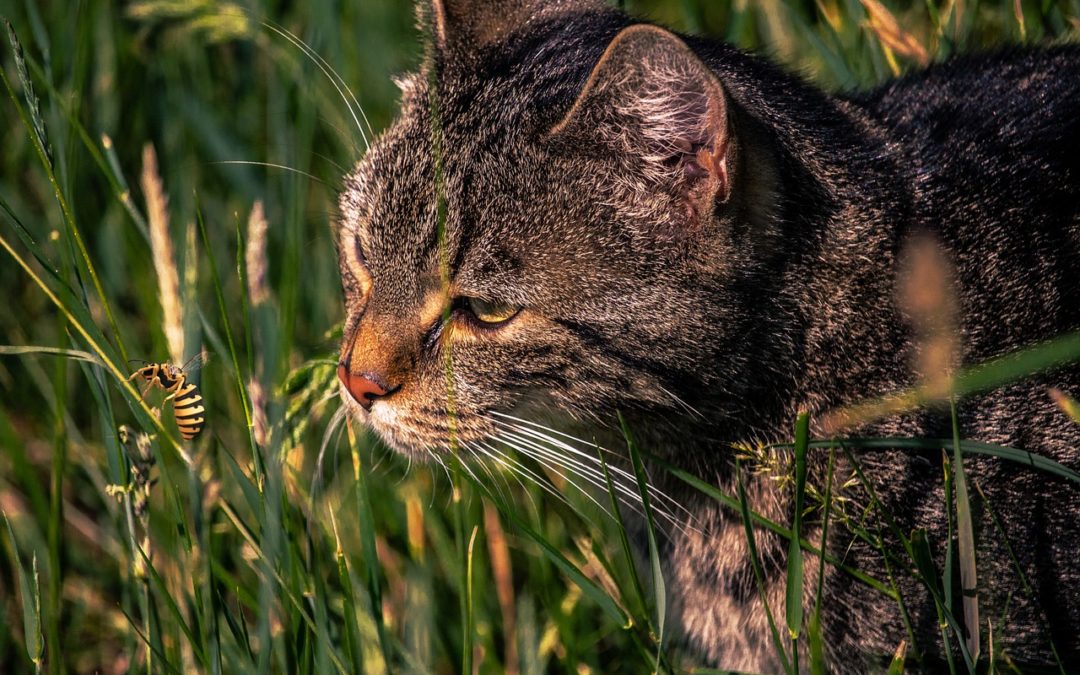
Wasp stings in cats can be a cause for concern among cat owners, especially during the warmer months when these stinging insects are more active. Cats, being naturally curious and playful, may see a buzzing wasp as an enticing plaything, which can lead to painful stings. In this comprehensive guide, we will cover everything you need to know about wasp stings in cats, including how to identify a sting, how to treat it, and how to prevent future stings. We’ll also discuss the services offered by Recon Pest Services, who can help homeowners in the greater Omaha and Lincoln areas safely remove bees and wasps from their homes and yards.
Why Do Cats Get Stung by Wasps?
Natural Curiosity and Hunting Instincts
Cats are known for their strong hunting instincts and inquisitive nature. The movement and buzzing sound of a wasp can trigger these instincts, leading cats to investigate, chase, and even attempt to catch the insect. Unfortunately, this playful behavior can result in a painful sting as the wasp defends itself.
Warm Weather and Increased Wasp Activity
Wasp stings in cats are more likely to occur during periods of warm weather when wasps are more active. Cats may encounter wasps while playing outside, or a wasp might find its way indoors, where it can pose a risk to indoor cats as well.
Identifying a Wasp Sting in Cats
Signs of a Wasp Sting
If your cat has been stung by a wasp, they may display some or all of the following signs:
- Sudden distress and pain
- Limping or favoring a paw
- Frantically licking or pawing at the affected area
- Swelling and redness at the site of the sting
- In severe cases, difficulty breathing or collapse
Common Areas for Wasp Stings
Wasp stings can occur anywhere on a cat’s body, but the most common areas are the face and paws, as these are the parts most likely to come into contact with the insect during play or exploration.
Treating Wasp Stings in Cats
Call Your Vet
If you suspect your cat has been stung by a wasp, it’s important to call your vet for advice. They can help you determine whether the reaction is mild, moderate, or severe, and guide you on the appropriate course of action.
First Aid for Wasp Stings
While waiting for veterinary advice, you can take some first-aid steps to help alleviate your cat’s discomfort:
- Apply a cold compress: Place an ice pack or a bag of frozen peas wrapped in a cloth on the affected area for 10 minutes to reduce swelling and pain.
- Monitor your cat: Keep a close eye on your cat for any signs of an allergic reaction or worsening symptoms, and contact your vet immediately if you notice any concerning changes.
Veterinary Treatment
In moderate to severe cases, your vet may administer anti-inflammatory medications to reduce swelling and pain. In extreme cases, your cat may need to be hospitalized for treatment, which could include intravenous fluids, oxygen therapy, and medications to counteract the allergic reaction.
Allergic Reactions to Wasp Stings in Cats
Recognizing an Allergic Reaction
Some cats may have an allergic reaction to wasp stings, which can range from mild to severe. Signs of an allergic reaction include:
- Extreme swelling and redness
- Hives or raised, red swellings on the body
- Difficulty breathing
- Vomiting or diarrhea
- Pale or brick-red gums
- Weakness or collapse
Treating an Allergic Reaction
If your cat shows signs of an allergic reaction to a wasp sting, it’s crucial to seek immediate veterinary care. Your vet may administer antihistamines, corticosteroids, and/or epinephrine to counteract the reaction, and may also provide supportive care such as IV fluids and oxygen therapy.
Preventing Wasp Stings in Cats
While it’s impossible to completely eliminate the risk of wasp stings in cats, there are some steps you can take to minimize the chances:
Remove Wasp Nests
If you find a wasp nest on your property, enlist the help of a professional pest control service like Recon Pest Services to safely remove it. Attempting to remove a nest yourself can be dangerous and may result in multiple stings for both you and your cat.
Keep Cats Indoors
Keeping your cat indoors, especially during the warmer months when wasps are more active, can help reduce the risk of wasp stings. If your cat enjoys spending time outside, consider creating a secure, enclosed outdoor space or “catio” where they can enjoy the outdoors without the risk of encountering stinging insects.
Monitor Indoor Wasps
During warmer months, be vigilant for any wasps that may have found their way indoors. If you spot a wasp inside your home, try to safely remove it without putting yourself or your cat at risk.
Recon Pest Services: Safely Removing Bees and Wasps
If you’re dealing with a bee or wasp infestation in your home or yard, Recon Pest Services can help. Serving the greater Omaha and Lincoln areas, Recon Pest Services specializes in the safe removal of common pests, including bees and wasps. By enlisting their professional services, you can protect both yourself and your cat from painful and potentially dangerous stings.
Monitoring Your Cat After a Wasp Sting
Even after treating a wasp sting, it’s important to continue monitoring your cat for any signs of complications or worsening symptoms. Keep an eye on their behavior, appetite, and litter box habits, and contact your vet if you notice any concerning changes.
Preparing for Future Stings
Unfortunately, there’s no way to predict how your cat will react to a wasp sting until it happens. Being prepared for the possibility of a sting and knowing how to respond can help ensure your cat receives the appropriate care and treatment as quickly as possible.
Create a Cat First Aid Kit
Having a cat first aid kit on hand can help you respond quickly and effectively to a variety of medical emergencies, including wasp stings. Include items such as cold packs, antihistamines (approved by your vet), and a card or similar tool for removing bee stingers.
Know Your Vet’s Emergency Contact Information
Make sure you have your vet’s emergency contact information readily available, as well as the location and contact information for the nearest emergency veterinary clinic.
The Importance of Bees in Our Ecosystem
While it’s essential to protect your cat from painful wasp stings, it’s important to remember that bees play a crucial role in our ecosystem. Bees are vital pollinators, helping to ensure the survival of countless plant species. When dealing with bees, the goal should be to safely remove them from your property without causing harm.
Keeping Your Cat Safe and Entertained
By providing your cat with plenty of toys and other forms of enrichment, you can help keep them entertained and less likely to engage with potentially dangerous insects like wasps. A well-cared-for and engaged cat is less likely to become a victim of painful wasp stings, ensuring their health, safety, and happiness.
In conclusion, wasp stings in cats can be a painful and potentially dangerous experience. By understanding the signs of a wasp sting, knowing how to treat it, and taking steps to prevent future stings, you can help protect your furry friend from these unpleasant encounters. And if you find yourself dealing with a bee or wasp infestation, don’t hesitate to contact Recon Pest Services for professional, safe removal services in the greater Omaha and Lincoln areas.



